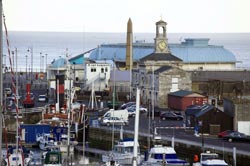Nikon AF-S DX 55-200 f/4-5.6 G ED
Available in both black and silver, this lens is Nikon’s offering in the popular ‘first extra lens’ category of 55-200mm, a handy length as it starts where most standard zooms finish. We take a look at how this one performs.
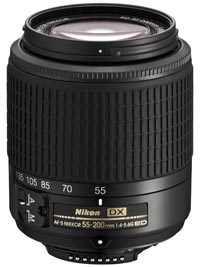 Specification
Specification
- Focal Length 55-200mm
- Construction 13/9 elements/groups
- Max aperture f/4-5.6
- Angle of view 36-10º
- Closest focus 0.95m
- Filter thread 52mm
- Dimensions 68x79mm
- Weight 0.255kg
- Hood HB-34 (supplied)
- Price £199.99
Build and Handling
The barrel of this lightweight lens is dominated by the 35mm of rubberised grip that is the zoom ring. There is an AF/MF switch in the usual place on the left, just in front of the mount and a token manual focus ring forward of the zoom ring that is some 5mm wide. The mount is constructed of engineering plastics that do seem a little more advanced than some others on the market, showing no signs of wear after a good number of lens changes.
The lens extends when zoomed by way of a double trombone action and is well done with virtually no play at full extension. A third trombone section extends for focussing, and by this time, with all three sections extended, a little lateral play is evident but it is by no means alarming. The lens is finished off with a deep flange for the bayonet fit, petal-shaped hood that is supplied with the lens.
The zoom ring produced a smooth transition through the marked focal lengths of 55, 70, 85, 105, 135 and 200mm, stiffening slightly as it reached the longer lengths. The process extends the length of the lens by some 35mm. A further 13mm is added to this length as the lens is focussed at its closest point of 0.95m, a handy distance.
Nikons new, lightweight SWM focussing system is quiet and fast enough for most purposes and I found it accurate in good light conditions with only the occasional hunt as the light lowered. However, in common with other lenses in this class, the AF cannot be over-ridden with the MF ring and for difficult subjects the AF needs to be switched off to use the manual ring. Although at first glance this looks to be a token affair, its position at the front of the zoom ring and the drop in diameter of the lens at this point makes it very usable. It is very easy to turn with a single digit but does not quite reach the point of feeling sloppy.
Optical Quality
This lens is designated as a DX lens, signifying its use is restricted to the cropped sensors of Nikons digital cameras and is not suitable for their film based cousins as they will vignette significantly.
The performance of this lens is impressive in the centre but average towards the edges. Like all of its ilk, the performance gets worse as the focal length increases and to get the optimum out of it the aperture needs closing down more nearer the longer end. With a lot of users cropping in software after capture, the balance is probably the best compromise.
Where this lens is let down slightly is in the control of distortion, with figures of 0.59% pincushion (acceptable) at the short end, going on to 1.8% pincushion (noticeable past 1.5%) at the longest focal length.
With that exception, which is easily curable in software, the lens has no other nasty characteristics, CA control and contrast both being good for the class.
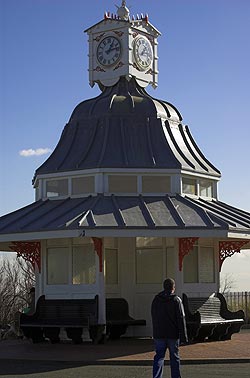 High contrast subjects were well coped with by this lens with no noticeable incidents of chromatic aberrations. Set at 55mm and shot at 1/400sec at f/8, ISO200 on a Nikon D50. |  The close focus distance of 0.95m is one of the best in class. 1/1250 and f/8, ISO200 and the focal length set to 85mm. |
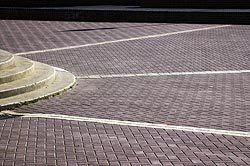 1/640sec and f/8 set at 85mm, the focal range of the lens allows for some creative framing. | 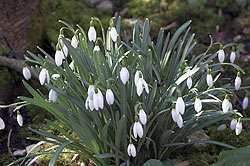 1/50sec and f/8 for these backlit snowdrops again showed no signs of chromatic aberrations. 66mm and ISO200 on a D50 |
Click on each comparision photo below to view full size versions
Below is our lens test data. To find out how to use these graphs look at this article: How we test lenses
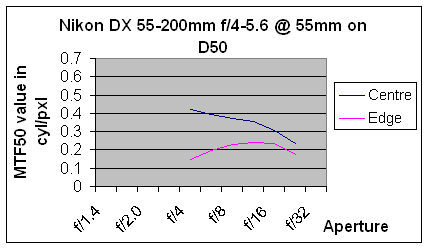
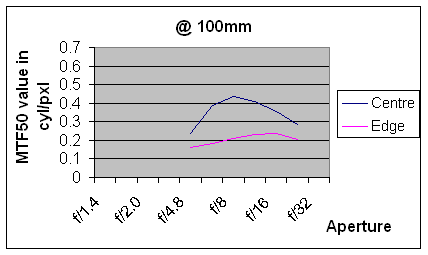
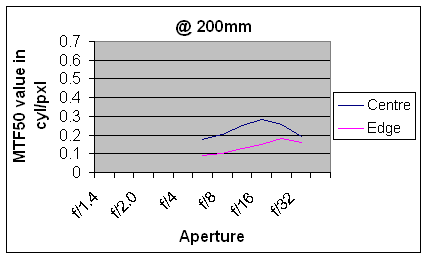
Verdict
Despite its lightweight construction this lens does not have a ‘cheap’ feel to it and the overall performance, although not stunning, is certainly not in the milk-bottle category. The autofocus performed satisfactorily and the manual mode proved usable. Supplied with both a hood and a soft bag for protection in the camera bag, it does seem good value for money.
In summary, the positive points of the Nikon DX AF-S 55-200mm are:
![]() Smallest and lightest in class
Smallest and lightest in class
![]() Good performance in centre.
Good performance in centre.
![]() Usable manual focus ring
Usable manual focus ring
![]() Good value for money
Good value for money
The negative points are:
![]() Pincushion distortion at the long end.
Pincushion distortion at the long end.
![]() Edge performance not as good as the centre.
Edge performance not as good as the centre.
Check the latest price for the Nikon DX AF-S 55-200mm f/4-5.6 G ED here
Test by Ian Andrews www.wildaboutkent.co.uk
Add your message
Please login here or if you've not registered, you can register here. Registering is safe, quick and free.
photodo Stats
428 MTF tests
74 in-depth photodo reviews
100+ users join each day
Help the lens community by reviewing or rating a lens today via our lens search
Latest Lens Reviews
- Chinon 28mm f/2.8 Vintage Lens Review
- Canon EF 70-200mm f/4L IS II USM Lens Review
- Samyang AF 85mm f/1.4 EF Review
- Sigma 70mm f/2.8 DG Macro Art Review
- Samyang AF 24mm f/2.8 FE Review
- Meike 50mm f/1.7 Review
- Tamron 70-210mm f/4 Di VC USD Review
- Lensbaby Burnside 35mm f/2.8 Review
- Asahi Super Takumar 50mm f/1.4 Review
- Asahi Super-Multi-Coated Takumar 135mm f/3.5 Review

